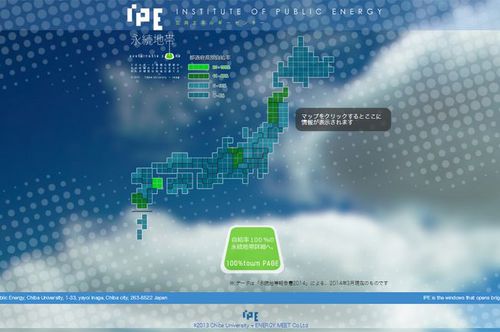September 4, 2016
Renewable Energy on the Rise in Japan: 100 Self-sufficient Municipalities, Oita Largest Prefectural Supplier by Self-sufficiency Ratio
Keywords: Civil Society / Local Issues Renewable Energy

Sustainable Zone Study website
As more renewable sources are added to the electricity grid in Japan, the ratio of renewable sources to all electricity sources is increasing in prefectures and municipalities across the country. As of March 31, 2015, the number of cities, towns, and villages where the renewable electricity supply was estimated to exceed the electricity demand reached 100. The following is an update on the status and progress of renewable energy deployment in Japan, based on an article courtesy of Smart Japan, an online media services provider specializing in energy conservation.
A group of researchers from Chiba University and the Institute for Sustainable Energy Policies (ISEP), a Japanese non-profit organization, has been conducting a joint research project called "Sustainable Zone Study" since 2007. The study measures the amount of renewable energy supplied and food produced by each municipality and, as a measure of local sustainability, calculates their self-sufficiency in energy and food, two resources essential to daily living.
When calculating the self-sufficiency of electricity based on the total electricity output from renewable sources (solar, wind, micro-hydro, geothermal, and biomass), Oita had the highest share of renewable electricity supply among all prefectures, at 38.6%. Oita is known to have a number of large geothermal plants, the output of which accounts for nearly half of the electricity supplied from renewable sources.
As for output by municipality, Kokonoe Town in Oita prefecture overwhelmingly topped the list. The town hosts the nation's largest geothermal plant, Hacchobaru Geothermal Power Plant, and three other large geothermal plants in operation, the supply from which pushes the town's self-sufficiency to more than 2,000%.
In second and third places were two villages in the southern part of Nagano prefecture. In these areas, hydropower is a common source of renewable electricity, as it takes advantage of water running down from high mountains in the South Japan Alps. In fourth and fifth came two villages in the southern area of Kumamoto prefecture. These villages are also capable of supplying a large amount of power from hydropower. The electricity self-sufficiency rates in the above four villages all exceeded 1,000%.
The 100 municipalities that are more than self-sufficient in renewable electricity represent an increase of five municipalities from a year ago. Most of these are small towns and villages, but nine are cities.
Renewable energy can also be used to generate heat. The Sustainable Zone research also calculates by prefecture the share of renewable energy supply, combining that of electricity and heat (solar, geothermal and biomass heat).
The renewable energy supply accounted for 10% or more of regional energy demand in 21 prefectures, an increase of seven prefectures from the previous survey (ended March 31, 2014). The Kyushu area contributed the most, with five prefectures including Oita at the top, followed by four each from the Tohoku and Kanto/Koshin-etsu areas, and three from the Chubu area.
The prefectures in Kyushu showed particularly remarkable increases in their renewable energy ratios. In Miyazaki, biomass power generation expanded three-fold and solar power doubled, which led to an increase in its renewable energy ratio of more than 6 percentage points from the previous year's survey, from 9.5% to 15.8%.
Solar was a major contributor to the increase in energy self-sufficiency in other prefectures. A typical example is Ibaraki prefecture, where the amount of electricity and heat supplied from renewable sources increased by 83% in a year, the highest growth rate among all 47 prefectures. The solar power supply increased 2.6-fold, with biomass generation rising 1.6-fold. Such expansion in its renewable energy supply put Ibaraki in second place in solar power supply and third place in biomass power supply. This also boosted its energy self-sufficiency from 5.2% to 9.4%.
The increase in renewable energy supply was observed in all prefectures. Ten prefectures saw an increase of more than 50%. And metropolitan areas are no exception: Tokyo saw a 30% rise and Osaka 47%, showing steady growth in renewables development across the country.
Source: Smart Japan (in Japanese)
Related JFS Articles
Related
"JFS Newsletter"
- 'Yumekaze' Wind Turbine Project Connects Metro Consumers and Regional Producers: Seikatsu Club Consumers' Co-operative
- Shaping Japan's Energy toward 2050 Participating in the Round Table for Studying Energy Situations
- Nishiawakura's Initiative for 100% Energy Self-Sufficiency, and a Municipal ICO Scheme
- Actions Toward 100% Renewable Energy in Japan
- Sustainable Community Building in Shimokawa: Recycling-Oriented Forest Management Enabling Permanent Use of Forest Resources
Related
"Popular Articles"
- Current Status of Renewable Energy in Japan (2015)
- Offshore Wind Farm Withstands Great East Japan Earthquake and Tsunami
- Current Status of Renewable Energy in Japan (2014)
- Geothermal Power: Japan Has World's Third Largest Geothermal Reserves, 60 Percent of Which Can Be Developed
- Tokyo Plans to Increase Renewable Energy Ratio to 20% by 2024


